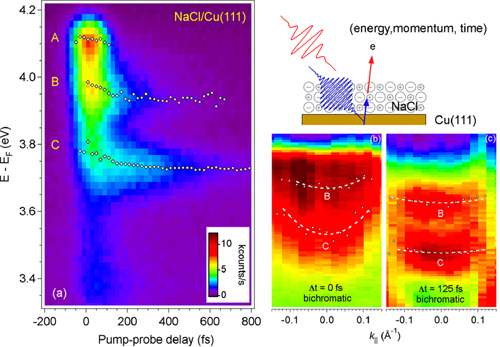07/11/2007
Watching an electron digging its own
grave in two-dimensions
Recent Research from the group of Professor
Xiaoyang Zhu.
Injecting an electron into a crystalline solid of
many materials can induce local distortion of the lattice. The result is
a polaron, i.e., a localized electron dressed by the much heavier nuclear
distortion. Understanding how a polaron forms is critical to the design
of materials for charge transport. In the June 15 issue of Physical
Review Letters [98, 246801
(2007)], MRSEC postdoc Matthias Muntwiler and Chemistry Professor Xiaoyang
Zhu reported a breakthrough discovery: an electron polaron unique to a
two-dimensional film, but not a three-dimensional crystal. The researchers
applied femtosecond time-resolved photoemission (TR-2PPE) spectroscopy
to directly observe the formation of polarons from the localization of
conduction band electrons in NaCl thin films of unit cell thickness. Contrary
to theoretical prediction for bulk NaCl crystal where an electron polaron
does not exist, small polarons readily form in crystalline NaCl thin films
on ~100 fs time scales. The increased deformability and the reduced electronic
bandwidth of a crystalline lattice in the thin film format are both responsible
for the formation of small polarons that are absent in bulk solids. This
finding is another manifestation of new physical properties that emerge
as physical sizes (in one of the three dimensions in the present case)
decrease to the nanometer scale. It has broad implications for research
into thin films of electronic materials.

Fig. 1: Panel (a): Two-dimensional pseudo-color
representation of 2PPE spectra as a function of pump-probe delay for 3ML
NaCl/Cu(111). The energy scale corresponds to intermediate state energy
referenced to the Fermi level. Peak positions of the two polarons (B & C)
are shown as white circles. Panels (b) & (c): Parallel dispersions
(kinetic energy vs. parallel momentum vector) of the electrons en route
to localization to form polarons. The effective mass of the electron increases
from 0.6-0.8 me at 0 fs to 3.2-3.5 me at 125 fs.
|